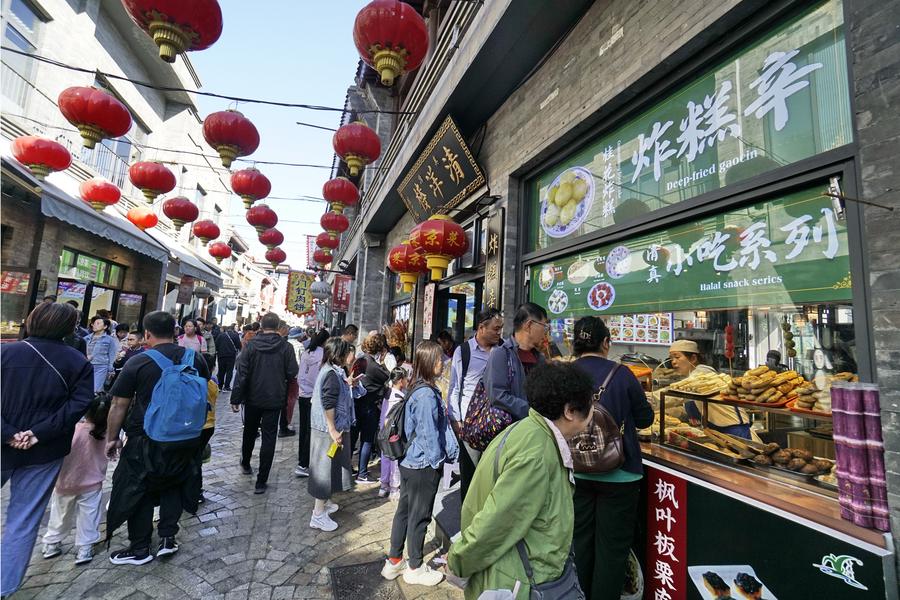

BEIJING, Oct. 8 (Xinhua) -- China's just-concluded National Day holiday ignited a surge in consumer activity, fueled by a dynamic blend of travel demand and targeted incentives, highlighting the strong economic vitality of the world's second largest economy.
Over the seven-day holiday ending on Monday, more than 2 billion cross-regional trips were made nationwide, according to the Ministry of Transport, representing a 4.1-percent average daily increase compared to 2023.
The surge in travel not only boosted tourism-related industries but also stimulated consumer spending across various sectors -- highlighting the resilience of China's domestic market during and beyond the holiday period.
Local governments and businesses responded to the travel rush with innovative initiatives, such as consumer vouchers and home appliance trade-in programs, aimed at tapping into the holiday spirit and bolstering consumption.

Visitors enjoy a light show at a scenic area in Yuhuan City, east China's Zhejiang Province, Oct. 4, 2024. (Photo by Duan Junli/Xinhua)
TOURISM BOOM WITH INBOUND SURGE
The holiday unleashed a travel frenzy. During the holiday period, a remarkable 765 million domestic trips were made, marking a 5.9 percent year-on-year increase, with total tourist spending surging 6.3 percent to 700.8 billion yuan (about 99.11 billion U.S. dollars).
The travel boom was fueled by a growing demand for diverse tourism experiences, with domestic bookings of travel packages, including flights, hotels and dining, jumping by 40 percent, according to Fliggy, a popular travel platform.
Data from Trip.com, another leading travel platform, showed that outbound travel orders had surpassed 2019 level, driven by trips to popular destinations such as Thailand, Malaysia, Singapore and Australia.
Notably, inbound tourism exceeded outbound travel, with inbound orders skyrocketing by 60 percent year on year during the holiday, as more foreign tourists flocked to China, drawn by its unique blend of natural beauty, historical landmarks and vibrant modern attractions.
The China Tourism Academy predicts that foreign arrivals in the second half of 2024 will exceed 15 million, with the inbound tourism market expected to return to 2019 level, marking the start of a new growth cycle.
Cultural tourism flourished during the holiday, seeing activities like museum visits, exhibitions and immersive experiences becoming major highlights. Beijing, for instance, hosted over 900 cultural events, an 11-percent increase compared with last year.

An aerial panoramic drone photo taken on Oct. 4, 2024 shows tourists visiting the Hukou Waterfall on the Yellow River, on the border area between north China's Shanxi and northwest China's Shaanxi provinces. (Xinhua/Chen Yehua)
Fueled by the blockbuster video game "Black Myth: Wukong," north China's Shanxi has recently seen a phenomenal travel boom, as this province is home to many of the stunning locations featured in the game.
Analysts expect that as more travelers engage with diverse cultures, the vibrant growth of China's economy and the richness of its cultural heritage will be fully showcased.
SPENDING BOOST WITH POLICY SUPPORT
The holiday also sparked a wave of consumer activity, with government-backed incentives playing a key role in heating up the market.

Tourists taste food at the Qianmen pedestrian street in Beijing, capital of China, Oct. 7, 2024. (Xinhua/Li Xin)
China unveiled an action plan in March this year to implement a program of large-scale equipment upgrades and trade-ins of consumer goods to expand domestic demand, and stepped up policy support in July with an extra funds injection of 300 billion yuan via ultra-long special treasury bonds.
Encouraged by the trade-in policy and automaker discounts, the holiday period saw new car sales increase by 11.7 percent -- with new energy vehicle sales surging 45.8 percent year on year.
During the holiday, JD.com, a leading online retailer, reported an increase of 67 percent in home appliance sales compared with 2023, while home appliance retailer, Suning, saw trade-in orders rising by 132 percent year on year.
According to the Ministry of Commerce, in the first three days of the holiday, 1.04 million consumers purchased 1.55 million home appliances under the trade-in program, contributing to sales of 7.36 billion yuan.
Powered by the travel and tourism surge, the dining sector across China sizzled with energy. Data from Meituan, one of China's leading e-commerce platforms for services, showed that from Oct.1 to 5, daily average dine-in consumption rose 33.4 percent compared to the same period last year.

A woman walks past film posters at a cinema in Tancheng County, east China's Shandong Province, Oct. 7, 2024. (Photo by Zhang Chunlei/Xinhua)
Audiences packed cinemas, with a total of 2.1 billion yuan in box office takings recorded during the holiday.
Local governments rolled out policy measures to spur consumption. Shanghai, for instance, injected 5 billion yuan into vouchers for dining, entertainment and shopping, while cities including Chongqing hosted a variety of promotions to spark consumption.
"The robust holiday consumption highlights China's vast market, and its strong economic resilience and great potential," said Xu Guangjian, a professor at the Renmin University of China.
The accelerated integration of culture, sports and tourism, along with evolving business models, is creating new opportunities for sustained growth, further consolidating the role of consumption as a key driver of the economy, Xu noted.
(Video reporters: Tang Yi, Yang Shuxin, Sun Lei, Huang Guobao, Huang Haoyuan, Li Shuai, Wang Kun, Zhang Mengjie; Video editors: Jia Xiaotong, Zheng Qingfu, Zheng Xin, Liu Xiaorui, Li Ziwei)
点击右上角![]() 微信好友
微信好友
 朋友圈
朋友圈

请使用浏览器分享功能进行分享
